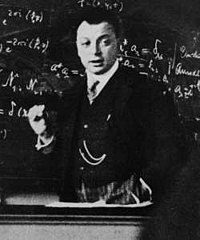
Back Uitsluitingsbeginsel van Pauli AF مبدأ استبعاد باولي Arabic পাউলিৰ নিষেধ নীতি AS Principiu d'esclusión de Pauli AST Прынцып Паўлі BE Принцип на Паули Bulgarian পাউলির অপবর্জন নীতি Bengali/Bangla Paulijev princip isključenja BS Principi d'exclusió de Pauli Catalan Pauli bók-siŏng-ṳ̀ng nguòng-lī CDO

| Part of a series of articles about |
| Quantum mechanics |
|---|
In quantum mechanics, the Pauli exclusion principle (German: Pauli-Ausschlussprinzip) states that two or more identical particles with half-integer spins (i.e. fermions) cannot simultaneously occupy the same quantum state within a system that obeys the laws of quantum mechanics. This principle was formulated by Austrian physicist Wolfgang Pauli in 1925 for electrons, and later extended to all fermions with his spin–statistics theorem of 1940.
In the case of electrons in atoms, the exclusion principle can be stated as follows: in a poly-electron atom it is impossible for any two electrons to have the same two values of all four of their quantum numbers, which are: n, the principal quantum number; ℓ, the azimuthal quantum number; mℓ, the magnetic quantum number; and ms, the spin quantum number. For example, if two electrons reside in the same orbital, then their values of n, ℓ, and mℓ are equal. In that case, the two values of ms (spin) pair must be different. Since the only two possible values for the spin projection ms are +1/2 and −1/2, it follows that one electron must have ms = +1/2 and one ms = −1/2.
Particles with an integer spin (bosons) are not subject to the Pauli exclusion principle. Any number of identical bosons can occupy the same quantum state, such as photons produced by a laser, or atoms found in a Bose–Einstein condensate.
A more rigorous statement is: under the exchange of two identical particles, the total (many-particle) wave function is antisymmetric for fermions and symmetric for bosons. This means that if the space and spin coordinates of two identical particles are interchanged, then the total wave function changes sign for fermions, but does not change sign for bosons.
So, if hypothetically two fermions were in the same state—for example, in the same atom in the same orbital with the same spin—then interchanging them would change nothing and the total wave function would be unchanged. However, the only way a total wave function can both change sign (required for fermions), and also remain unchanged is that such a function must be zero everywhere, which means such a state cannot exist. This reasoning does not apply to bosons because the sign does not change.
- ^ "Wolfgang Pauli during a lecture in Copenhagen". Retrieved 2023-09-11.
